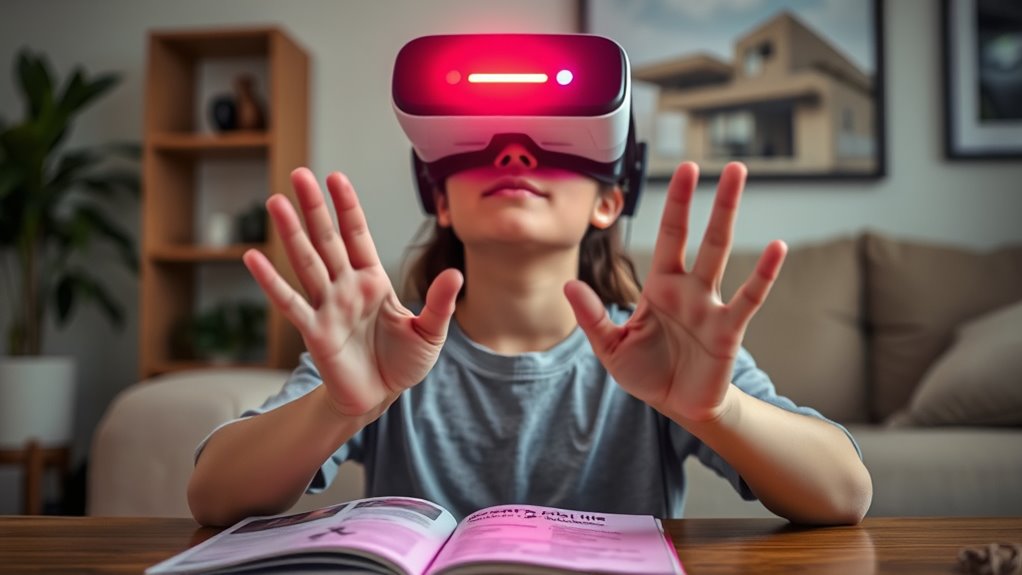To use a VR headset safely, prioritize your well-being and environment. Take regular breaks to reduce eye strain and discomfort. Stay hydrated and be aware of your surroundings to prevent physical injuries from trips or falls. Understand that VR can cause motion sickness, so listen to your body and adjust settings as needed. While it’s unlikely to be life-threatening, careful usage is essential for a more enjoyable experience. There’s more to discover about keeping yourself safe in VR.
Understanding the Risks of VR Technology
While virtual reality (VR) offers immersive experiences that can transport you to new worlds, it is vital to recognize the potential risks associated with its use. One significant concern is the health implications that can arise from prolonged exposure to VR environments. Users often experience symptoms like eye strain, headaches, and motion sickness due to the disconnect between physical movement and virtual stimuli. Additionally, wearing a VR headset for extended periods can lead to discomfort or even physical injuries if you’re not aware of your surroundings. It’s essential to take breaks, stay hydrated, and maintain a safe play area to mitigate these risks. By understanding the potential health implications, you can enjoy VR while prioritizing your well-being and personal freedom.
Common Myths About VR Safety
Many misconceptions surround VR safety that can lead users to underestimate the potential risks. One common myth is that VR is completely safe and can’t cause any physical harm. In reality, users can experience dizziness, nausea, or even disorientation after extended use. Another safety myth suggests that VR doesn’t impact mental health; however, prolonged immersion in virtual environments can lead to issues like anxiety or desensitization. Additionally, some believe that VR headsets are only dangerous for young children, ignoring that anyone can experience adverse effects. Understanding these VR misconceptions is vital for responsible usage. By recognizing these safety myths, you can make informed choices and enjoy your VR experience while minimizing risks.
Essential Safety Tips for VR Users
As you plunge into the immersive world of virtual reality, it’s crucial to prioritize your safety to enhance your experience. First, make certain your play area is clear of obstacles to prevent accidents. Use VR accessories, like wrist straps and protective covers, to safeguard against drops and damage. Pay attention to user ergonomics; adjust your headset for comfort to avoid strain during extended sessions. Take regular breaks to rest your eyes and maintain focus. Make sure to stay hydrated and be aware of your surroundings, especially if you’re using room-scale VR. Finally, consider adjusting the brightness and contrast settings to reduce eye fatigue. By following these important tips, you can enjoy VR safely and freely.
Recognizing Signs of VR Motion Sickness
Recognizing the signs of VR motion sickness is essential for maintaining an enjoyable experience, especially since symptoms can vary widely among users. Common motion sickness symptoms include dizziness, nausea, sweating, and disorientation. If you start feeling uneasy or experience any of these signs, it’s vital to take immediate action. You might want to pause the VR session, remove the headset, and take deep breaths to stabilize your senses. Engaging in prevention techniques, such as taking breaks, adjusting your headset’s settings, or gradually increasing your VR exposure time, can help you adapt better. Remember, everyone’s tolerance differs, so listen to your body and prioritize your comfort to fully enjoy your virtual adventures.
Creating a Safe VR Environment
Creating a safe VR environment is essential not only for enhancing your immersive experience but also for preventing accidents and injuries. Start with effective virtual space organization; clear any obstacles to guarantee you have a free area to move around. Arrange your equipment placement thoughtfully, positioning cables and devices away from your walking path to avoid tripping hazards. Use mats or markers to define your play space, helping you maintain awareness of your surroundings. Regularly check your setup for any potential hazards, and adjust as needed. By taking these steps, you can enjoy the freedom of virtual reality while minimizing risks. Ultimately, a well-organized space allows you to focus on your experience without distractions or safety concerns.
Frequently Asked Questions
Can VR Headsets Cause Long-Term Eye Damage?
VR headsets can contribute to eye strain and vision fatigue, but they’re unlikely to cause long-term damage if used responsibly. Make sure to take breaks, adjust settings, and maintain a comfortable distance for ideal safety.
Are There Age Restrictions for VR Headset Use?
Yes, there are age guidelines for VR headset use. Manufacturers typically recommend children under 12 avoid VR due to safety recommendations. Always check the specific device’s guidelines to guarantee a safe and enjoyable experience.
Can VR Usage Affect Mental Health Negatively?
Yes, VR usage can negatively affect mental health. Immersive experiences might trigger VR anxiety or amplify stress, creating a disconnect from reality. Balancing your time in virtual worlds is essential for maintaining mental well-being and stability.
What Should I Do if I Feel Dizzy After VR?
If you feel dizzy after VR, take a break and rest. Stay hydrated, focus on a stable object, and try dizziness remedies like ginger. Gradually return to VR for a smoother recovery and avoid prolonged sessions.
How Do VR Games Impact Physical Fitness Levels?
VR games can boost your fitness; studies show they can burn up to 400 calories per hour during virtual workouts. Immersive exercises engage you physically and mentally, making workouts feel less like chores and more enjoyable.

